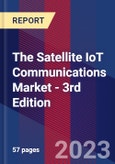The Number of Satellite IoT Subscribers to Reach 23.9 Million in 2027
This study investigates the satellite IoT connectivity market. The research covers a total of 44 satellite IoT operators including both the incumbent operators and all the new LEO smallsat constellations. The global satellite IoT communications market is growing at a steady pace. The global satellite IoT subscriber base grew to surpass 4.5 million in 2022. The number of satellite IoT subscribers will increase at a compound annual growth rate (CAGR) of 39.6 percent to reach 23.9 million units in 2027. Get up to date with the latest information and trends about the satellite IoT business opportunity.
The global satellite IoT subscriber base grew to surpass 4.5 million in 2022. The number of satellite IoT subscribers will increase at a compound annual growth rate (CAGR) of 39.6 percent to reach 23.9 million units in 2027. Only about 10 percent of the Earth’s surface has access to terrestrial connectivity services which leaves a massive opportunity for satellite IoT communications. Satellite connectivity provides a complement to terrestrial cellular and non-cellular networks in remote locations, especially useful for applications in agriculture, asset tracking, maritime and intermodal transportation, oil and gas industry exploration, utilities, construction and governments. Both incumbent satellite operators and more than two dozen new initiatives are now betting on the IoT connectivity market. This new study covers a total of 44 satellite IoT operators.
“Iridium, Orbcomm, Inmarsat and Globalstar are the largest satellite IoT network operators today”, states the Principal Analyst. Iridium grew its subscriber base by 20 percent in the last year and reached the number one spot serving 1.5 million subscribers. Originally a dedicated satellite operator, Orbcomm has transitioned into an end-to-end solution provider, delivering services on its own satellite network as well as being a reseller partner of Inmarsat and others.
At the end of Q4-2022, the company had 1.1 million satellite IoT subscribers on its own and Inmarsat’s networks. At the same time, Globalstar reached 0.44 million subscribers. Other players with connections in the tens of thousands include for instance Myriota in Australia, Kineis in France and Thuraya in the UAE. In addition to the incumbent satellite operators, a number of new initiatives have appeared on the market recently. Examples of some high-profile projects are Astrocast, AST SpaceMobile, CASC/CASIC, E-Space, Fleet Space Technologies, Hubble Network, Kepler Communications, Kineis, Ligado Networks, Lynk, Myriota, Omnispace, Skylo, Swarm Technologies (SpaceX) and Totum. Many of these are based on low-earth orbit nano satellite concepts.
While some rely on proprietary satellite connectivity technologies to support IoT devices, several are starting to leverage terrestrial wireless IoT connectivity technologies including OQ Technology, AST SpaceMobile, Omnispace, Sateliot, Galaxy Space, Ligado Networks, Lynk, Skylo and Starlink (3GPP 4G/5G); EchoStar Mobile, Fossa Systems, Lacuna Space, Innova Space and Eutelsat (LoRaWAN); and Hubble Network (Bluetooth). “Collaborations between satellite operators and mobile operators that explore new hybrid satellite-terrestrial connectivity opportunities will become common in the next years and recent examples include Telefónica & Sateliot, Deutsche Telekom & Intelsat/Skylo and Soracom & Astrocast”, concludes the analyst.
Highlights from the report:
- 360-degree overview of the satellite IoT communications ecosystem.
- Reviews of the strategies of 44 satellite IoT operators.
- Perspectives on the impact of the new LEO nano satellite constellations.
- Summary of the latest industry trends and developments.
- Reviews of operator market shares and competitive dynamics.
- Extensive global and regional market forecasts lasting until 2027.
This report answers the following questions:
- Which IoT applications are most relevant for satellite connectivity?
- What are the latest developments in the satellite IoT communications market?
- How will the emerging LEO nanosatellite constellations affect the market?
- What are the market shares for the leading satellite IoT operators?
- What are the regional developments in North America, Europe, China and ROW?
- How is the competitive landscape of satellite IoT operators evolving?
- How will the global satellite IoT market evolve over the next five years?
Who should read this report?
The Satellite IoT Communications Market is the foremost source of information about the emerging satellite IoT connectivity market. Whether you are a device vendor, service provider, satellite operator, investor, consultant, or government agency, you will gain valuable insights from our in-depth research.
Table of Contents
Executive Summary
Companies Mentioned (Partial List)
A selection of companies mentioned in this report includes, but is not limited to:
- Amazon
- AST SpaceMobile
- Astrocast
- Boeing
- CASC and CASIC
- CASC/CASIC
- Chinese satellite operators
- Commsat
- Deutsche Telekom
- E-Space
- EchoStar Mobile
- eSAT Global
- Eutelsat
- Fleet Space Technologies
- Fossa Systems
- Galaxy Space
- Geely
- Globalstar
- Guodian Tech
- Head Aerospace
- Hiber
- hiSky
- Hubble Network
- Ingenu
- Inmarsat
- Innova Space
- Intelsat/Skylo
- Iridium
- Kepler Communications
- Kineis
- Lacuna Space
- Ligado Networks
- Linksure
- Lynk
- Myriota
- Omnispace
- OneWeb
- OQ Technology
- Orbcomm
- Roscosmos
- Sateliot
- Sky and Space Company
- Skylo
- Soracom
- Starlink
- Swarm Technologies (SpaceX)
- Telefónica
- Telesat
- Thuraya
- Totum
Methodology

LOADING...








